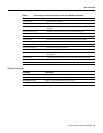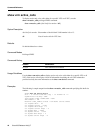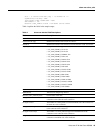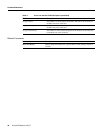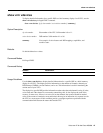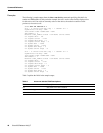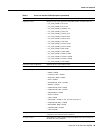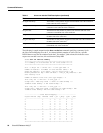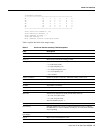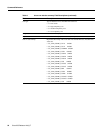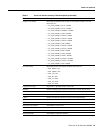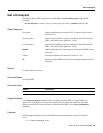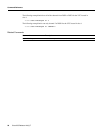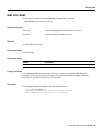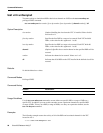
show vrm vdevices
Voice over IP for the Cisco AS5800 51
<information deleted>
+++++++++++++++++++++++++++++++++++++++++++++++++++++++++++
91 16 1 2 0 0 0
92 16 2 2 0 0 0
93 16 3 1 0 0 0
94 16 4 2 0 0 0
95 16 5 2 0 0 0
96 16 6 2 0 0 0
+++++++++++++++++++++++++++++++++++++++++++++++++++++++++++
Total active call channels = 178
Total busied out channels = 0
Total channels in reset = 0
Total bad channels = 0
Note :Channels could be in multiple states
Table 6 explains the fields in the sample output.
Table 6 show vrm vdevice summary Field Descriptions
Field Description
slot Slot number where VFC is installed.
major ver Major version of firmware running on VFC.
minor ver Minor version of firmware running on VFC.
core type used Type of DSPware in use. Possible field values are:
• 1 = UBL (boot loader)
• 2 = high complexity core
• 3 = medium complexity core
• 4 = low complexity core
• 255 = invalid.
number of modules Number of modules on the VFC. Maximum number possible is 16.
number of voice devices (DSP)s Number of possible DSPs. Maximum number is 96.
chans per vdevice Number of channels (meaning calls) each DSP can handle.
tot chans Total number of channels.
tot active calls Total number of active calls on this VFC.
module presense bit map Indicates a 16-bit bitmap, each bit representing a module.
tdm mode Time division multiplex bus mode. Possibe field values are:
• 0 = VFC is in classic mode
• 1 = VFC is in plus mode.
This field should always be 1.
num_of_tdm_timeslots Total number of calls that can be handled by the VFC.
auto recovery Indicates whether auto recovery is enabled. When autorecovery is enabled,
the VRM will try to recover a DSP by resetting it if, for some reason, the DSP
stops responding.
number of default voice file (core
type images)
Number of DSPware files in use.
maj ver Major version of the DSPware in use.
min ver Minor version of the DSPware in use.



